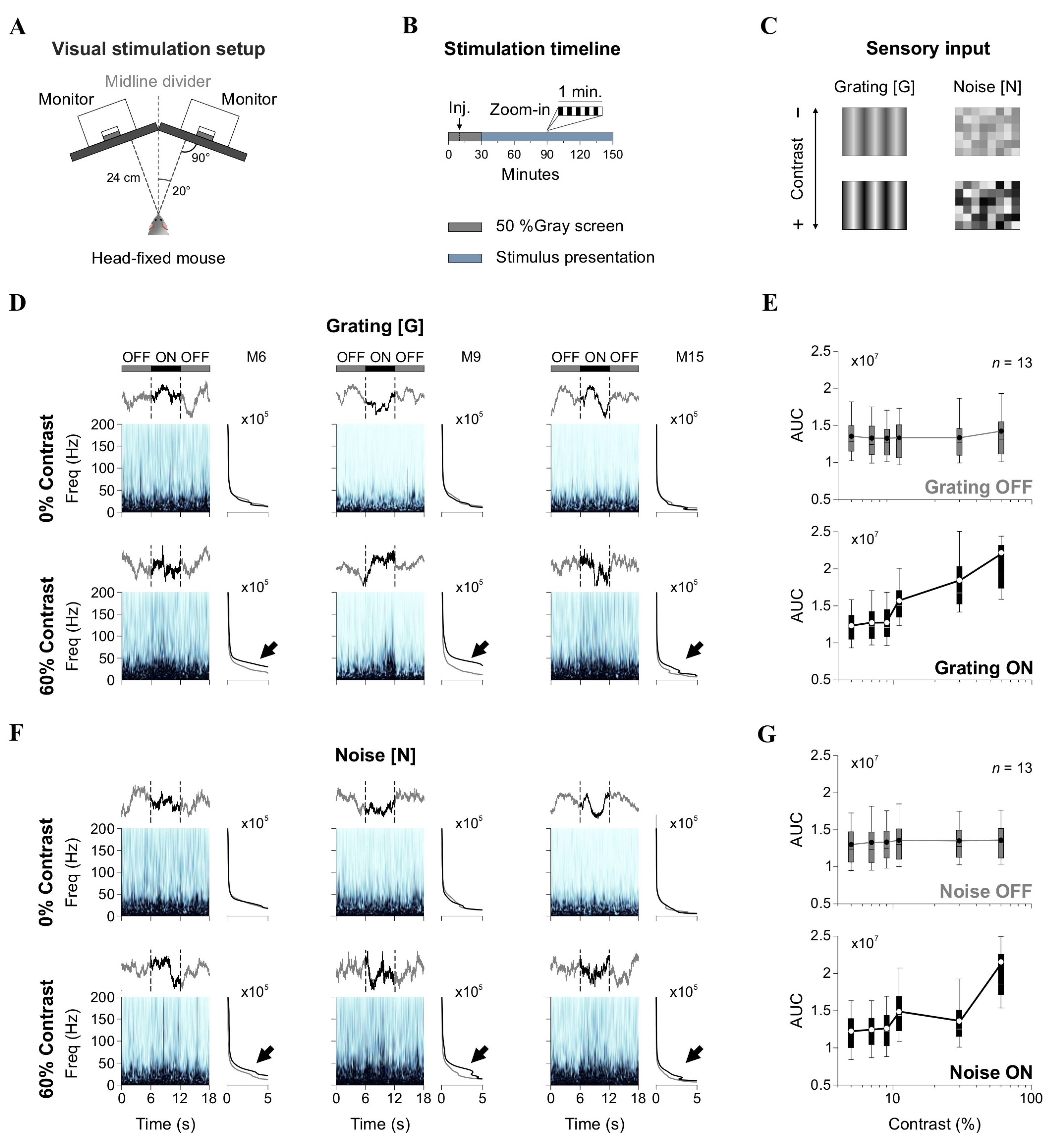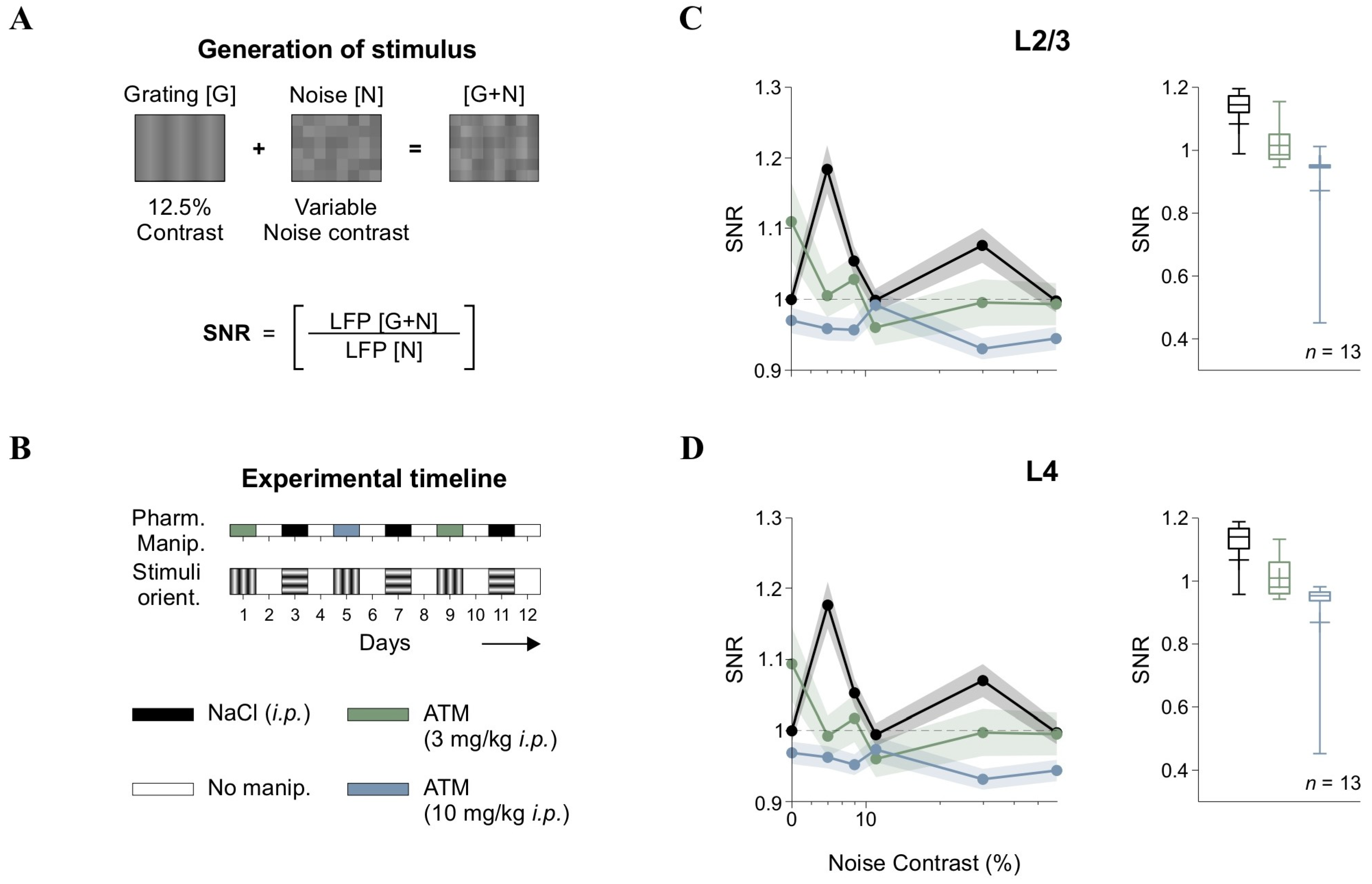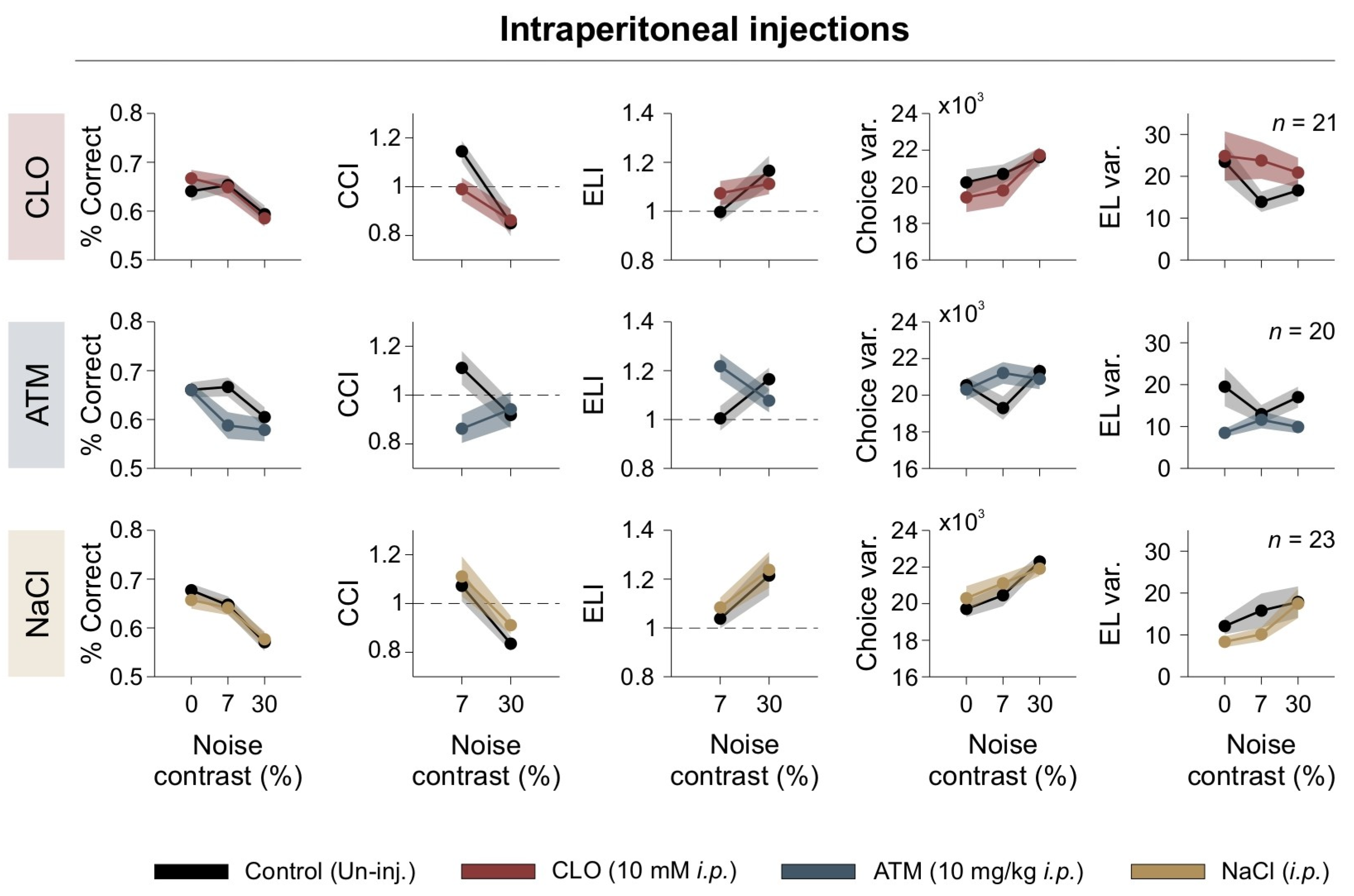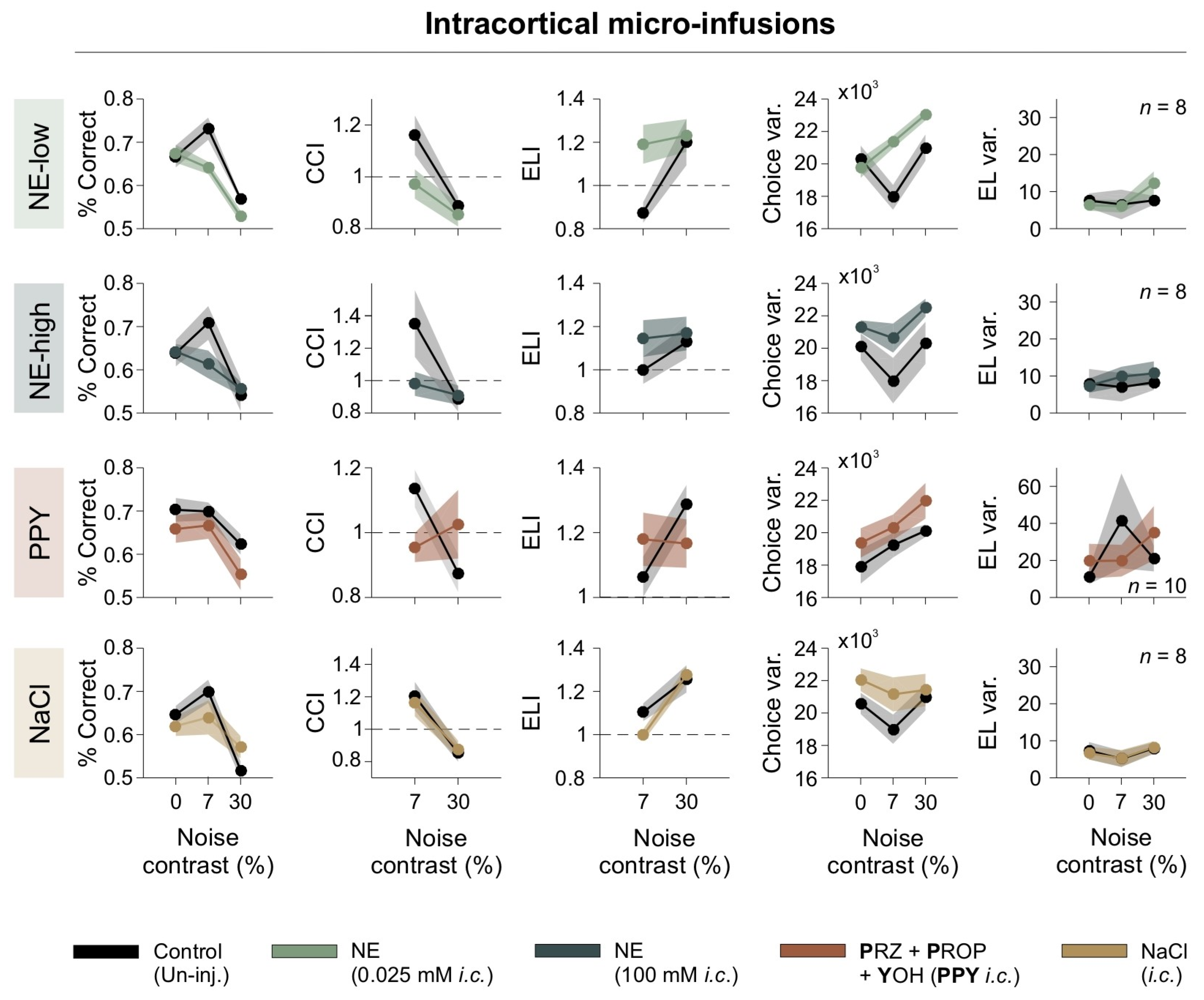Adrenergic Modulation of Cortical Gain and Sensory Processing in the Mouse Visual Cortex
Abstract
1. Introduction
2. Materials and Methods
2.1. Animals
2.2. Surgical Procedures
2.3. Visual Stimuli
2.4. Electrophysiological Experiments
2.5. Partial Directed Coherence
2.6. Behavioral Experiments
2.7. Histology
2.8. Statistical Analysis
3. Results
3.1. Sensitivity of LFP Power to Grating and Noise Contrast in V1
3.2. Atomoxetine Disrupts the SNR Response Function in the Visual Cortex
3.3. Atomoxetine Disrupts Interlaminar Communication in the Visual Cortex
3.4. Nonlinear Relationship Between Visual Discrimination and Noise Contrast
3.5. Noradrenergic Modulation of Visual Discrimination Across Varying Levels of Visual Noise
3.6. Intracortical Adrenergic Modulation of Visual Discrimination
4. Discussion
Author Contributions
Funding
Institutional Review Board Statement
Informed Consent Statement
Data Availability Statement
Acknowledgments
Conflicts of Interest
Abbreviations
| CCI | Correct Choice Index |
| ELI | Escape Latency Index |
| ACh | Acetylcholine |
| ATM | Atomoxetine |
| AUC | Area Under the Curve |
| CLO | Clonidine |
| dLGN | Dorsal Lateral Geniculate Nucleus |
| EL | Escape Latency |
| FPS | Frames Per Second |
| GABA | Gamma-Aminobutyric Acid |
| i.c. | Intracortical |
| i.p. | Intraperitoneal |
| KW | Kruskal–Wallis Test |
| L2/3 | Layer 2/3 of Cortex |
| L4 | Layer 4 of Cortex |
| LC | Locus Coeruleus |
| LFP | Local Field Potential |
| NE | Norepinephrine |
| PDC | Partial Directed Coherence |
| PPY | Prazosin + Propranolol + Yohimbine |
| RM-ANOVA | Repeated-Measures ANOVA |
| SEM | Standard Error of the Mean |
| SNR | Signal-to-Noise Ratio |
| SR | Stochastic Resonance |
| V1 | Primary Visual Cortex |
References
- Aihara, T.; Kitajo, K.; Nozaki, D.; Yamamoto, Y. Internal Noise Determines External Stochastic Resonance in Visual Perception. Vis. Res. 2008, 48, 1569–1573. [Google Scholar] [CrossRef]
- Ikemoto, S.; DallaLibera, F.; Hosoda, K. Noise-Modulated Neural Networks as an Application of Stochastic Resonance. Neurocomputing 2018, 277, 29–37. [Google Scholar] [CrossRef]
- Mori, T.; Kai, S. Noise-Induced Entrainment and Stochastic Resonance in Human Brain Waves. Phys. Rev. Lett. 2002, 88, 218101. [Google Scholar] [CrossRef] [PubMed]
- Goris, R.L.T.; Wagemans, J.; Wichmann, F.A. Modelling Contrast Discrimination Data Suggest Both the Pedestal Effect and Stochastic Resonance to Be Caused by the Same Mechanism. J. Vis. 2008, 8, 17. [Google Scholar] [CrossRef]
- Treviño, M.; De la Torre-Valdovinos, B.; Manjarrez, E. Noise Improves Visual Motion Discrimination via a Stochastic Resonance-Like Phenomenon. Front. Hum. Neurosci. 2016, 10, 572. [Google Scholar] [CrossRef]
- Ferguson, K.A.; Cardin, J.A. Mechanisms Underlying Gain Modulation in the Cortex. Nat. Rev. Neurosci. 2020, 21, 80–92. [Google Scholar] [CrossRef]
- Treviño, M. Inhibition Controls Asynchronous States of Neuronal Networks. Front. Synaptic Neurosci. 2016, 8, 11. [Google Scholar] [CrossRef]
- Nienborg, H.; Hasenstaub, A.; Nauhaus, I.; Taniguchi, H.; Huang, Z.J.; Callaway, E.M. Contrast Dependence and Differential Contributions from Somatostatin- and Parvalbumin-Expressing Neurons to Spatial Integration in Mouse V1. J. Neurosci. 2013, 33, 11145–11154. [Google Scholar] [CrossRef]
- Kapadia, M.K.; Westheimer, G.; Gilbert, C.D. Dynamics of Spatial Summation in Primary Visual Cortex of Alert Monkeys. Proc. Natl. Acad. Sci. USA 1999, 96, 12073–12078. [Google Scholar] [CrossRef]
- Meneghetti, N.; Cerri, C.; Tantillo, E.; Vannini, E.; Caleo, M.; Mazzoni, A. Narrow and Broad γ Bands Process Complementary Visual Information in Mouse Primary Visual Cortex. eNeuro 2021, 8, ENEURO.0106-21.2021. [Google Scholar] [CrossRef]
- Saleem, A.B.; Lien, A.D.; Krumin, M.; Haider, B.; Rosón, M.R.; Ayaz, A.; Reinhold, K.; Busse, L.; Carandini, M.; Harris, K.D. Subcortical Source and Modulation of the Narrowband Gamma Oscillation in Mouse Visual Cortex. Neuron 2017, 93, 315–322. [Google Scholar] [CrossRef]
- Henrie, J.A.; Shapley, R. LFP Power Spectra in V1 Cortex: The Graded Effect of Stimulus Contrast. J. Neurophysiol. 2005, 94, 479–490. [Google Scholar] [CrossRef]
- Nauhaus, I.; Busse, L.; Carandini, M.; Ringach, D.L. Stimulus Contrast Modulates Functional Connectivity in Visual Cortex. Nat. Neurosci. 2009, 12, 70–76. [Google Scholar] [CrossRef]
- Cone, J.J.; Scantlen, M.D.; Histed, M.H.; Maunsell, J.H.R. Different Inhibitory Interneuron Cell Classes Make Distinct Contributions to Visual Contrast Perception. eNeuro 2019, 6, ENEURO.0337-18.2019. [Google Scholar] [CrossRef] [PubMed]
- Polack, P.-O.; Friedman, J.; Golshani, P. Cellular Mechanisms of Brain State-Dependent Gain Modulation in Visual Cortex. Nat. Neurosci. 2013, 16, 1331–1339. [Google Scholar] [CrossRef] [PubMed]
- Atzori, M.; Cuevas-Olguin, R.; Esquivel-Rendon, E.; Garcia-Oscos, F.; Salgado-Delgado, R.C.; Saderi, N.; Miranda-Morales, M.; Treviño, M.; Pineda, J.C.; Salgado, H. Locus Ceruleus Norepinephrine Release: A Central Regulator of CNS Spatio-Temporal Activation? Front. Synaptic Neurosci. 2016, 8, 25. [Google Scholar] [CrossRef]
- Salgado, H.; Köhr, G.; Treviño, M. Noradrenergic “tone” Determines Dichotomous Control of Cortical Spike-Timing-Dependent Plasticity. Sci. Rep. 2012, 2, 417. [Google Scholar] [CrossRef]
- Salgado, H.; Treviño, M.; Atzori, M. Layer- and Area-Specific Actions of Norepinephrine on Cortical Synaptic Transmission. Brain Res. 2016, 1641, 163–176. [Google Scholar] [CrossRef]
- Treviño, M.; Medina-Coss Y León, R.; Lezama, E. Adrenergic Modulation of Visually-Guided Behavior. Front. Synaptic Neurosci. 2019, 11, 9. [Google Scholar] [CrossRef]
- Treviño, M.; Fregoso, E.; Sahagún, C.; Lezama, E. An Automated Water Task to Test Visual Discrimination Performance, Adaptive Strategies and Stereotyped Choices in Freely Moving Mice. Front. Behav. Neurosci. 2018, 12, 251. [Google Scholar] [CrossRef]
- Treviño, M.; Medina-Coss Y León, R. Distributed Processing of Side-Choice Biases. Brain Res. 2020, 1749, 147138. [Google Scholar] [CrossRef] [PubMed]
- Román Rosón, M.; Bauer, Y.; Kotkat, A.H.; Berens, P.; Euler, T.; Busse, L. Mouse dLGN Receives Functional Input from a Diverse Population of Retinal Ganglion Cells with Limited Convergence. Neuron 2019, 102, 462–476.e8. [Google Scholar] [CrossRef] [PubMed]
- Treviño, M.; Frey, S.; Köhr, G. Alpha-1 Adrenergic Receptors Gate Rapid Orientation-Specific Reduction in Visual Discrimination. Cereb. Cortex 2012, 22, 2529–2541. [Google Scholar] [CrossRef]
- Treviño, M.; Oviedo, T.; Jendritza, P.; Li, S.-B.; Köhr, G.; De Marco, R.J. Controlled Variations in Stimulus Similarity during Learning Determine Visual Discrimination Capacity in Freely Moving Mice. Sci. Rep. 2013, 3, 1048. [Google Scholar] [CrossRef]
- Priebe, N.J.; McGee, A.W. Mouse Vision as a Gateway for Understanding How Experience Shapes Neural Circuits. Front. Neural Circuits 2014, 8, 123. [Google Scholar] [CrossRef]
- Frenkel, M.Y.; Sawtell, N.B.; Diogo, A.C.M.; Yoon, B.; Neve, R.L.; Bear, M.F. Instructive Effect of Visual Experience in Mouse Visual Cortex. Neuron 2006, 51, 339–349. [Google Scholar] [CrossRef]
- Torrence, C.; Compo, G.P. A Practical Guide to Wavelet Analysis. Bull. Am. Meteorol. Soc. 1998, 79, 61–78. [Google Scholar] [CrossRef]
- Manjarrez, E.; Diez-Martínez, O.; Méndez, I.; Flores, A. Stochastic Resonance in Human Electroencephalographic Activity Elicited by Mechanical Tactile Stimuli. Neurosci. Lett. 2002, 324, 213–216. [Google Scholar] [CrossRef]
- Omidvarnia, A.; Azemi, G.; Boashash, B.; O’Toole, J.M.; Colditz, P.B.; Vanhatalo, S. Measuring Time-Varying Information Flow in Scalp EEG Signals: Orthogonalized Partial Directed Coherence. IEEE Trans. Biomed. Eng. 2014, 61, 680–693. [Google Scholar] [CrossRef]
- Rumyantsev, O.I.; Lecoq, J.A.; Hernandez, O.; Zhang, Y.; Savall, J.; Chrapkiewicz, R.; Li, J.; Zeng, H.; Ganguli, S.; Schnitzer, M.J. Fundamental Bounds on the Fidelity of Sensory Cortical Coding. Nature 2020, 580, 100–105. [Google Scholar] [CrossRef]
- Sorrentino, A.; Parkkonen, L.; Piana, M.; Massone, A.M.; Narici, L.; Carozzo, S.; Riani, M.; Sannita, W.G. Modulation of Brain and Behavioural Responses to Cognitive Visual Stimuli with Varying Signal-to-Noise Ratios. Clin. Neurophysiol. 2006, 117, 1098–1105. [Google Scholar] [CrossRef] [PubMed]
- Gorea, A.; Sagi, D. Disentangling Signal from Noise in Visual Contrast Discrimination. Nat. Neurosci. 2001, 4, 1146–1150. [Google Scholar] [CrossRef] [PubMed]
- Zhu, Y.; Qiao, W.; Liu, K.; Zhong, H.; Yao, H. Control of Response Reliability by Parvalbumin-Expressing Interneurons in Visual Cortex. Nat. Commun. 2015, 6, 6802. [Google Scholar] [CrossRef]
- Bennett, C.; Arroyo, S.; Hestrin, S. Subthreshold Mechanisms Underlying State-Dependent Modulation of Visual Responses. Neuron 2013, 80, 350–357. [Google Scholar] [CrossRef]
- Soma, S.; Shimegi, S.; Suematsu, N.; Tamura, H.; Sato, H. Modulation-Specific and Laminar-Dependent Effects of Acetylcholine on Visual Responses in the Rat Primary Visual Cortex. PLoS ONE 2013, 8, e68430. [Google Scholar] [CrossRef]
- Senzai, Y.; Fernandez-Ruiz, A.; Buzsáki, G. Layer-Specific Physiological Features and Interlaminar Interactions in the Primary Visual Cortex of the Mouse. Neuron 2019, 101, 500–513.e5. [Google Scholar] [CrossRef]
- Bastos, A.M.; Litvak, V.; Moran, R.; Bosman, C.A.; Fries, P.; Friston, K.J. A DCM Study of Spectral Asymmetries in Feedforward and Feedback Connections between Visual Areas V1 and V4 in the Monkey. Neuroimage 2015, 108, 460–475. [Google Scholar] [CrossRef]
- Schmidt, S.L.; Chew, E.Y.; Bennett, D.V.; Hammad, M.A.; Fröhlich, F. Differential Effects of Cholinergic and Noradrenergic Neuromodulation on Spontaneous Cortical Network Dynamics. Neuropharmacology 2013, 72, 259–273. [Google Scholar] [CrossRef] [PubMed]
- Sajedin, A.; Menhaj, M.B.; Vahabie, A.-H.; Panzeri, S.; Esteky, H. Cholinergic Modulation Promotes Attentional Modulation in Primary Visual Cortex- A Modeling Study. Sci. Rep. 2019, 9, 20186. [Google Scholar] [CrossRef]
- Chen, N.; Sugihara, H.; Sur, M. An Acetylcholine-Activated Microcircuit Drives Temporal Dynamics of Cortical Activity. Nat. Neurosci. 2015, 18, 892–902. [Google Scholar] [CrossRef]
- Fu, Y.; Kang, Y.; Chen, G. Stochastic Resonance Based Visual Perception Using Spiking Neural Networks. Front. Comput. Neurosci. 2020, 14, 24. [Google Scholar] [CrossRef] [PubMed]
- Pavan, A.; Ghin, F.; Contillo, A.; Milesi, C.; Campana, G.; Mather, G. Modulatory Mechanisms Underlying High-Frequency Transcranial Random Noise Stimulation (Hf-tRNS): A Combined Stochastic Resonance and Equivalent Noise Approach. Brain Stimul. 2019, 12, 967–977. [Google Scholar] [CrossRef] [PubMed]
- Cody, P.A.; Tzounopoulos, T. Neuromodulatory Mechanisms Underlying Contrast Gain Control in Mouse Auditory Cortex. J. Neurosci. 2022, 42, 5564–5579. [Google Scholar] [CrossRef] [PubMed]
- Millman, D.J.; Ocker, G.K.; Caldejon, S.; Kato, I.; Larkin, J.D.; Lee, E.K.; Luviano, J.; Nayan, C.; Nguyen, T.V.; North, K.; et al. VIP Interneurons in Mouse Primary Visual Cortex Selectively Enhance Responses to Weak but Specific Stimuli. eLife 2020, 9, e55130. [Google Scholar] [CrossRef]
- Treviño, M.; Medina-Coss y León, R.; Haro, B. Adaptive Choice Biases in Mice and Humans. Front. Behav. Neurosci. 2020, 14, 99. [Google Scholar] [CrossRef]
- van der Groen, O.; Wenderoth, N. Transcranial Random Noise Stimulation of Visual Cortex: Stochastic Resonance Enhances Central Mechanisms of Perception. J. Neurosci. 2016, 36, 5289–5298. [Google Scholar] [CrossRef]
- Manjarrez, E.; Rojas-Piloni, G.; Méndez, I.; Flores, A. Stochastic Resonance within the Somatosensory System: Effects of Noise on Evoked Field Potentials Elicited by Tactile Stimuli. J. Neurosci. 2003, 23, 1997–2001. [Google Scholar] [CrossRef]
- Li, Y.T.; Ma, W.P.; Li, L.Y.; Ibrahim, L.A.; Wang, S.Z.; Tao, H.W. Broadening of Inhibitory Tuning Underlies Contrast-Dependent Sharpening of Orientation Selectivity in Mouse Visual Cortex. J. Neurosci. Off. J. Soc. Neurosci. 2012, 32, 16466–16477. [Google Scholar] [CrossRef]
- Zatka-Haas, P.; Steinmetz, N.A.; Carandini, M.; Harris, K.D. Sensory Coding and the Causal Impact of Mouse Cortex in a Visual Decision. eLife 2021, 10, e63163. [Google Scholar] [CrossRef]
- Bymaster, F.P.; Katner, J.S.; Nelson, D.L.; Hemrick-Luecke, S.K.; Threlkeld, P.G.; Heiligenstein, J.H.; Morin, S.M.; Gehlert, D.R.; Perry, K.W. Atomoxetine Increases Extracellular Levels of Norepinephrine and Dopamine in Prefrontal Cortex of Rat: A Potential Mechanism for Efficacy in Attention Deficit/Hyperactivity Disorder. Neuropsychopharmacology 2002, 27, 699–711. [Google Scholar] [CrossRef]
- Faisal, A.A.; Wolpert, D.M. Near Optimal Combination of Sensory and Motor Uncertainty in Time during a Naturalistic Perception-Action Task. J. Neurophysiol. 2009, 101, 1901–1912. [Google Scholar] [CrossRef] [PubMed]
- McDonnell, M.D.; Ward, L.M. The Benefits of Noise in Neural Systems: Bridging Theory and Experiment. Nat. Rev. Neurosci. 2011, 12, 415–426. [Google Scholar] [CrossRef] [PubMed]
- Roberts, M.J.; Lowet, E.; Brunet, N.M.; Ter Wal, M.; Tiesinga, P.; Fries, P.; De Weerd, P. Robust Gamma Coherence between Macaque V1 and V2 by Dynamic Frequency Matching. Neuron 2013, 78, 523–536. [Google Scholar] [CrossRef] [PubMed]
- Fries, P. A Mechanism for Cognitive Dynamics: Neuronal Communication through Neuronal Coherence. Trends Cogn. Sci. 2005, 9, 474–480. [Google Scholar] [CrossRef]
- Bosman, C.A.; Schoffelen, J.-M.; Brunet, N.; Oostenveld, R.; Bastos, A.M.; Womelsdorf, T.; Rubehn, B.; Stieglitz, T.; De Weerd, P.; Fries, P. Attentional Stimulus Selection through Selective Synchronization between Monkey Visual Areas. Neuron 2012, 75, 875–888. [Google Scholar] [CrossRef]
- Dinstein, I.; Heeger, D.J.; Behrmann, M. Neural Variability: Friend or Foe? Trends Cogn. Sci. 2015, 19, 322–328. [Google Scholar] [CrossRef]
- Urai, A.E.; Braun, A.; Donner, T.H. Pupil-Linked Arousal Is Driven by Decision Uncertainty and Alters Serial Choice Bias. Nat. Commun. 2017, 8, 14637. [Google Scholar] [CrossRef]
- Eldar, E.; Cohen, J.D.; Niv, Y. The Effects of Neural Gain on Attention and Learning. Nat. Neurosci. 2013, 16, 1146–1153. [Google Scholar] [CrossRef]
- Thiele, A.; Bellgrove, M.A. Neuromodulation of Attention. Neuron 2018, 97, 769–785. [Google Scholar] [CrossRef]
- Buffalo, E.A.; Fries, P.; Landman, R.; Buschman, T.J.; Desimone, R. Laminar Differences in Gamma and Alpha Coherence in the Ventral Stream. Proc. Natl. Acad. Sci. USA 2011, 108, 11262–11267. [Google Scholar] [CrossRef]
- Spaak, E.; Bonnefond, M.; Maier, A.; Leopold, D.A.; Jensen, O. Layer-Specific Entrainment of γ-Band Neural Activity by the α Rhythm in Monkey Visual Cortex. Curr. Biol. 2012, 22, 2313–2318. [Google Scholar] [CrossRef] [PubMed]
- Joshi, S.; Gold, J.I. Pupil Size as a Window on Neural Substrates of Cognition. Trends Cogn. Sci. 2020, 24, 466–480. [Google Scholar] [CrossRef]
- You, W.-K.; Mysore, S.P. Dynamics of Visual Perceptual Decision-Making in Freely Behaving Mice. eNeuro 2022, 9, ENEURO.0161-21.2022. [Google Scholar] [CrossRef]
- Treviño, M.; Medina-Coss Y León, R.; Lezama, E. Response Time Distributions and the Accumulation of Visual Evidence in Freely Moving Mice. Neuroscience 2022, 501, 25–41. [Google Scholar] [CrossRef] [PubMed]
- Shi, T.; Feng, S.; Zhou, Z.; Li, F.; Fu, Y.; Zhou, W. Stress-Altering Anterior Insular Cortex Activity Affects Risk Decision-Making Behavior in Mice of Different Sexes. Front. Cell. Neurosci. 2023, 17, 1094808. [Google Scholar] [CrossRef] [PubMed]
- Kobayashi, K.; Hsu, M. Neural Mechanisms of Updating under Reducible and Irreducible Uncertainty. J. Neurosci. 2017, 37, 6972–6982. [Google Scholar] [CrossRef]
- van den Berg, R.; Zylberberg, A.; Kiani, R.; Shadlen, M.N.; Wolpert, D.M. Confidence Is the Bridge between Multi-Stage Decisions. Curr. Biol. 2016, 26, 3157–3168. [Google Scholar] [CrossRef]
- Jahn, C.I.; Gilardeau, S.; Varazzani, C.; Blain, B.; Sallet, J.; Walton, M.E.; Bouret, S. Dual Contributions of Noradrenaline to Behavioural Flexibility and Motivation. Psychopharmacology 2018, 235, 2687–2702. [Google Scholar] [CrossRef]
- Kurikawa, T.; Haga, T.; Handa, T.; Harukuni, R.; Fukai, T. Neuronal Stability in Medial Frontal Cortex Sets Individual Variability in Decision-Making. Nat. Neurosci. 2018, 21, 1764–1773. [Google Scholar] [CrossRef]
- Iigaya, K.; Ahmadian, Y.; Sugrue, L.P.; Corrado, G.S.; Loewenstein, Y.; Newsome, W.T.; Fusi, S. Deviation from the Matching Law Reflects an Optimal Strategy Involving Learning over Multiple Timescales. Nat. Commun. 2019, 10, 1466. [Google Scholar] [CrossRef]






Disclaimer/Publisher’s Note: The statements, opinions and data contained in all publications are solely those of the individual author(s) and contributor(s) and not of MDPI and/or the editor(s). MDPI and/or the editor(s) disclaim responsibility for any injury to people or property resulting from any ideas, methods, instructions or products referred to in the content. |
© 2025 by the authors. Licensee MDPI, Basel, Switzerland. This article is an open access article distributed under the terms and conditions of the Creative Commons Attribution (CC BY) license (https://creativecommons.org/licenses/by/4.0/).
Share and Cite
Medina-Coss y León, R.; Lezama, E.; Márquez, I.; Treviño, M. Adrenergic Modulation of Cortical Gain and Sensory Processing in the Mouse Visual Cortex. Brain Sci. 2025, 15, 406. https://doi.org/10.3390/brainsci15040406
Medina-Coss y León R, Lezama E, Márquez I, Treviño M. Adrenergic Modulation of Cortical Gain and Sensory Processing in the Mouse Visual Cortex. Brain Sciences. 2025; 15(4):406. https://doi.org/10.3390/brainsci15040406
Chicago/Turabian StyleMedina-Coss y León, Ricardo, Elí Lezama, Inmaculada Márquez, and Mario Treviño. 2025. "Adrenergic Modulation of Cortical Gain and Sensory Processing in the Mouse Visual Cortex" Brain Sciences 15, no. 4: 406. https://doi.org/10.3390/brainsci15040406
APA StyleMedina-Coss y León, R., Lezama, E., Márquez, I., & Treviño, M. (2025). Adrenergic Modulation of Cortical Gain and Sensory Processing in the Mouse Visual Cortex. Brain Sciences, 15(4), 406. https://doi.org/10.3390/brainsci15040406






